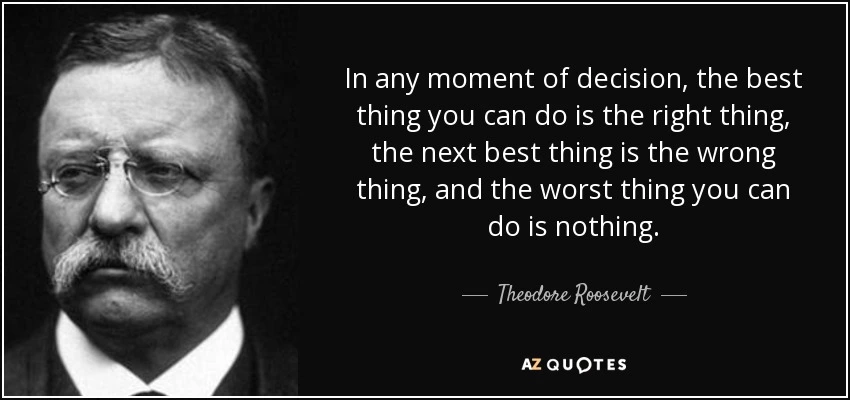I’ve been told by teaching colleagues that I am too analytical. It’s a pretty good read. I’ve never been comfortable flying by the seat of my pants. I’d rather have as much information as I can get and have the pieces more or less in place before making a move.
Although that one Teddy Roosevelt quote hangs behind my desk because sometimes you just have to make a decision.
It’s not always possible to have all the knowledge you need. To be honest, a key moment in my life was when I learned to operate in a grey area, when “black-and-white” is not one of the options.
Did I ever tell you about the time we bought a house sight-unseen? Moving back to the Region from Vegas, we had enough money to fly back for job interviews but not enough to come back a second time for house hunting. We did our research online (on the baby Internet back in 2005), my wife’s stepdad was our agent, we’d find a house, he’d check it out and report back. He eventually did the walkthrough of the house we selected on his flip phone while we stood in the kitchen of our house in Vegas.
Sold. We never saw it in person until we pulled up in the U-Haul.
That’s when I understood the Colin Powell 40-70 rule. General Powell felt if he couldn’t be 40% sure the outcome of a decision, that was a “no”. But he also recognized he would never have 100% of the information, so he set 70% as the threshold. Once he was 70% positive, that was a “go”.
And so it is in so many areas of life. Gather your data, assess the probabilities, move forward. It’s why the probability unit in Algebra II is so rich with opportunities for real-life connections. Yeah, we do do plenty of Fundamental Counting Principle practice, we figure permutations and combinations (“How many ways can three runners finish first, second, and third in the 100-meter dash in a field of eight runners?”)
But the big money payoff is when students see how understanding probabilities and likely outcomes can help them manage an uncertain (at best) world.
We start the prob/stats unit with a deep dive into March Madness, including a bracket challenge with their new-found handicapping knowledge.
Then out of long habit I make the assessment for the unit a pair of activities: First (because Indiana), John Scammell’s “Free Throws For The Win” .
We follow that up with an investigation into the Monty Hall Problem (doc here). Both days they do real math and see the real applications of probability that they can start using really as soon as tomorrow.
The big takeaways are that even what seem like highly improbable things still sometimes happen. And that just because something is statistically your best move doesn’t always guarantee success. You have twice the probability of winning the car on Let’s Make A Deal by switching doors, but in any one play (which is all you get when you are a contestant), there is still a 1-in-3 chance you get the Zonk.
Weigh your options, and roll.
A lot of my friends in the building are making exactly these mental calculations these days. At our next school board meeting next week the district is expected to announce its decision on school closures and teacher layoffs. Consensus is we will shutter 4 of our 12 elementary schools, and we were told back in November that the defeat of a funding referendum would require cutting 250 teaching positions.
But as a colleague of mine pointed out, folks aren’t waiting. In his words, they are “RIFfing themselves”, lining up new jobs before the axe can fall. In some cases, making the move before the school year is done. We had four resignations from just my building on the personnel report last month, and I suspect the number will be similar this month. (That’s 10 percent of our teaching staff in eight weeks, if you’re scoring at home). And can you blame them? As the famous economist observation goes, when you lose your job, unemployment in your house is 100%. It doesn’t matter what the “official” statistics say.
I’ve been on the other side. Some time ago I left the district I call “the Family Business” for a green leafy suburban school. Well, the grass isn’t always greener. I came back. For the people and the kids. I took a pay cut to do it. There’s no district out there where the hallways are paved with gold. Few are paying significantly more than we are. There are so many districts (even in relatively affluent areas) in financial distress right now, it’s the living embodiment of “the devil you know”. You could jump districts and land someplace worse.
I feel horrible for the families who will have to make plans for their kids to attend a different school next year. For the kids who will leave their friends. I ache for my teacher friends who are going to be forced out of a job they’ve poured their soul into. For the clerical staff and custodians who won’t even be allowed to finish out the year. I’ve been told that due to the number of vacancies and emergency permit folks in the district, teachers with a degree and a license are probably safe. But even for the folks who are above the cut line, the daily anxiety over the future permeating my building is physically exhausting.
And the concessions that will likely be written into our contract (yeah that’s not even settled yet, five months after the state-mandated deadline to conclude negotiations) are frankly petty and punitive and are chasing teachers away. Folks who stay will get no raise and shoulder the burden of an unsustainable insurance premium increase.
Tuesday of Holy Week, this line from the Gospel of John hit hard:
Jesus answered, “It is the one to whom I hand the morsel after I have dipped it.” So he dipped the morsel and [took it and] handed it to Judas, son of Simon the Iscariot. After he took the morsel, Satan entered him. So Jesus said to him, “What you are going to do, do quickly.”
https://www.biblegateway.com/passage/?search=John%2013:26-28&version=NABRE
That’s all of us right now: whatever the plan is, get on with it. Just tell us. Then we can take that information and make a decision.
Just like they taught us back in Algebra II all those years ago.



















